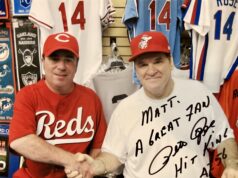BY JEFF ZURCHER
Color Guard
“The Cats left pre-game warm-ups with white caps and returned from the locker room with metallic midnight-blue bonnets.”
Colors matter.

Ask every make-up artist in the mall. Ask every used car salesman. Ask every kindergarten teacher.
Ask all those women who had their “colors done” in the ’80s. (If you ask me, that was a scam.)

Schauss was the first to claim that Baker-Miller Pink®, known as “drunk tank pink,” calmed irate imprisoned individuals.
“Even if a person tries to be angry or aggressive in the presence of pink, he can’t. The heart muscles can’t race fast enough. It’s a tranquilizing color that saps your energy. Even the color-blind are tranquilized by pink rooms.” 1
The color is now being used in more than 1400 government hospitals and correctional facilities in the U.S.
Amen.
College football coaches were soon to catch on.
According to the Honolulu Star Bulletin, in 1991, University of Hawaii assistant coach George Lumkin noticed that the visitor locker rooms at the University of Iowa and at Colorado State University were painted pink (either the Baker-Miller variety or some similar hue) – in order to calm the visiting teams’ demeanors.
Lumkin got mad, or as close to mad as one can get when in a pink room. And he complained.
Thereafter, the Western Athletic Conference, in which Hawaii participates (and Colorado State used to), implemented a rule stating that the visiting team’s locker room can’t be painted a different color than the home team’s.
At the University of Kentucky, the locker room walls are white. And for decades, the helmets have been too.
But last Saturday against Ole Miss, Kentucky got the blues.
The Cats left pre-game warm-ups with white caps and returned from the locker room with metallic midnight-blue bonnets.
“We’ve had those helmets for a while,” said Kentucky coach Guy Morriss, “we were just waiting for the right time to break them out.”
Going into the game at 1-2, last Saturday was a fine time for that break out (or a break out of any other kind).
And the helmets were a fine surprise – not just to the fans, but to the players as well.
“The blue helmets were the coaches’ decision. They got us psyched up,” said junior running back Martez Johnson, who turned in 39 yards on 9 carries versus the Rebels.
“We liked something different.”
But what the fans and players would have liked even more were different results. The Cats dropped their eleventh-straight SEC game with a 42-31 defeat.
“It’s always important to look good,” said senior safety Patrick Wiggins. “But we didn’t play good. We were flat.”
And ironically, one of the reasons for Kentucky’s complacency, Wiggins believes, was due to the new blue helmets.
“The helmets created excitement and energy. But we put too much stock in that [excitement and energy] in the beginning.”
And the beginning could be considered to constitute Ole Miss’s first three possessions, each of which resulted in a Rebel touchdown.
Yet just as he wouldn’t have attributed the blue helmets (and pants) to a win, Wiggins doesn’t blame the color scheme for the loss.
“It was great to change things up. I hope we stay blue,” he said. “I like playing in these colors – it’s a great thing for the defense; plays into the mentality. The darker colors make us feel more aggressive [another phenomenon proven by social sciences] but our play has got to match that characterization.”
Amen again.
However, sophomore guard Nick Seitze, who last year played defense and this year plays offensive line – and did a great job filling in for Keith Chatelain against Ole Miss – doesn’t see the blue as providing an advantage.
“The blue really didn’t matter,” he said. “How you look can’t determine how you play.”
But after a pause, Seitze chuckled a concession, “The O-line is a different bunch of guys, though.”
“We’re already fat enough, so we don’t care how we look.”
1 Walker, Morton. The Power of Color, New York: Avery Publishing Group, 1991, pp. 50-52




